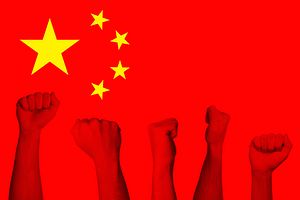Over the past month, a widespread online and offline campaign in China has emerged to support the production of cotton in Xinjiang and denounce international clothing brands that pledged to eschew its use over forced labor concerns. At first glance, the effort – complete with viral hashtags and celebrity support – may look like grassroots support for the Chinese Communist Party’s (CCP) efforts to hit back at criticism of its human rights abuses committed against Uyghurs and other Turkic Muslims. And yet, even as some participation in the campaign is inevitably organic, its media dimensions point to strong party-state backing.
The online campaign emerged on March 24, sparked by a viral Weibo post from the Communist Youth League (CYL) – the CCP’s youth arm – that pledged support for cotton from Xinjiang and denounced international brands like Swedish clothing company H&M. The campaign focused on clothing brands that had announced in 2020 that they would cut ties to Xinjiang factories in light of evidence that cotton from Xinjiang, which amounts to 20 percent of the world’s supply, was picked through forced labor by Uyghurs and other Turkic Muslims. Forced labor in Xinjiang has been cited as evidence of crimes against humanity in Xinjiang, and several governments issued coordinated sanctions on Chinese officials over the issue two days before the CYL’s post.
Although the campaign began online, state media propaganda organs inside the country soon began promoting it through traditional media. The CCP mouthpiece People’s Daily released several articles, including one on why Xinjiang cotton is the “best in the world,” while a live broadcast on China Central Television (CCTV) advertised products made from Xinjiang cotton and denounced “international brands [that] want to make money in China while stigmatizing Xinjiang cotton.” Government ministry spokespersons also joined in, promoting the narrative that the allegations of forced labor were “malicious lies” with the purpose of discrediting China’s image or preventing China’s development. The propaganda offensive also expanded to cinemas, and a musical on Xinjiang premiered in theaters on March 28.
The campaign received widespread support on social media, with the “Support Xinjiang cotton” hashtag gaining more than 7.9 billion views on Weibo by April 21. State media boosted the social media campaign, and one of the most widely shared posts using the hashtag came from People’s Daily, whose post was shared over 39 million times. Participating netizens vowed to boycott the brands, with some users burning Nikes and posting video of the spectacle; several landlords shuttered H&M stores, and dozens of celebrities severed endorsement deals with H&M, Adidas, and other brands whose leadership had criticized abuses in Xinjiang. Despite this seemingly grassroots outcry, online sentiment on topics like Xinjiang cotton can be difficult to accurately gauge, as trends are easily manipulated or amplified by a robust industry of government-funded “intelligent online commenting” that can flood social media platforms with desired posts, even at the direction of small agencies.
Perceived public opinion on certain issues is also distorted by the deletion of comments that counter the officially endorsed narrative. While most responses from netizens and consumers appeared to support the CCP narrative on Xinjiang cotton, Chinese censors were also at work controlling dissent. Weibo banned two accounts for posting the slogan “support Xinjiang people,” and soon after, searching for terms related to supporting Uyghurs or others in Xinjiang on most platforms produced irrelevant results. The country’s private tech companies effectively erased H&M’s online presence, pulling products from online shopping malls and the H&M name from mapping and ride-share services and food delivery apps. Huawei also pulled Nike and Adidas apps from their app store. Streaming platforms and television stations blurred the logos of clothing worn on shows.
State media and diplomats aggressively promoted the campaign overseas on state-run social media accounts and in English-language media. “Xinjiang” was the most-mentioned topic by government and diplomatic Twitter accounts between March 24 and April 21, according to the Hamilton 2.0 dashboard, which tracks trends on global social media platforms by government accounts from China and other authoritarian environments. CGTN also released two propaganda documentaries with English subtitles.
The overseas campaign also had a more sinister element. On Weibo, more than 7 million people viewed posts attacking the lead author of a report on Uyghur forced labor, Chinese Australian Vicky Xu Xiuzhong. She also received death threats, and her friends in China were briefly detained. Other measures included retaliatory sanctions on academics Jo Smith Finley and Adrien Zenz, parading detained Uyghurs on state television in attempts to silence their overseas family members, and a cyberattack on the website of the Inter-Parliamentary Alliance on China, an international cross-party group of legislators critical of the Chinese government and its mistreatment of Uyghurs.
By manipulating the state media and online response in support of Xinjiang cotton, the CCP has demonstrated its ability and willingness to deploy nationalist sentiment to counter international criticism over human rights issues. Future business and human rights concerns in China will likely see a similar response from Chinese consumers.
The party-state blurs the line between genuine anger and manufactured outrage as it grooms nationalist voices online, presides over a compliant domestic tech sector, and controls a vast media ecosystem. By selectively loosening media controls on such a sensitive (and often censored) topic, the CCP is demonstrating its confidence in this approach. Meanwhile, a genuine discussion over the brutal treatment of Uyghurs and Turkic Muslims is lost in a sea of social media posts, with many Chinese users defending Xinjiang cotton over the people living in the region.































